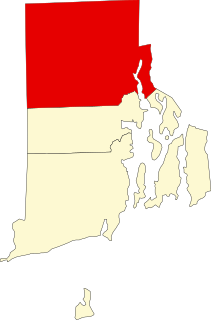
Wakefield is a village in the town of South Kingstown, Rhode Island, and the commercial center of the town. Together with the village of Peace Dale, it is treated by the U.S. Census as a component of the census-designated place identified as Wakefield-Peacedale, Rhode Island. West Kingston, another South Kingstown village, was the traditional county seat of Washington County. Since 1991, the Washington County Courthouse has been in Wakefield. The Sheriff's Office which handles corrections is also in Wakefield.

The Florence Mill, known later as the U. S. Envelope Building, is a former industrial facility located at 121 West Main Street in the Rockville section of Vernon, Connecticut. Developed in stages between 1864 and 1916, it exhibits changes in mill construction technology over that period, include a rare early example of Second Empire architecture. Now converted into senior housing, it was listed on the National Register of Historic Places in 1978.

Ironstone is an historic village,, in the township of Uxbridge, Massachusetts, United States. It derived its name from plentiful bog iron found here which helped Uxbridge to become a center for three iron forges in the town's earliest settlement. South Uxbridge has historic sites, picturesque weddings, hospitality, industrial and distribution centers, and the new Uxbridge High School. This community borders North Smithfield, and Burrillville, Rhode Island, and Millville, Massachusetts. South Uxbridge receives municipal services from Uxbridge, for fire, police, EMS, School district, public works, and other services. There is a South Uxbridge fire station of the Uxbridge fire department. Worcester's Judicial District includes Uxbridge District Court. Ironstone appears on the Blackstone U.S. Geological Survey Map. Worcester County is in the Eastern time zone and observes DST.

The Dyerville Mill is an historic textile mill complex at 610 Manton Avenue in Providence, Rhode Island, USA. Its oldest buildings dating to 1835, it is one the oldest textile mill in the city. The complex is located between Manton Avenue and the Woonasquatucket River, just south of the Dyerville Mill Pond. Remnants of the head race run south from the pond, through the property, with the tail race exiting to the southwest. The main mill building is a 3-1/2 story L-shaped stuccoed stone structure. The picker house is a 2-1/2 story stone structure southwest of the main mill, with a brick extension that also gives it an L shape and creates a courtyard with the main building. A 20th-century warehouse stands south of this complex. The mill was established by Elisha Dyer, father of Elisha Dyer and grandfather of Elisha Dyer, Jr., and was operated by the Dyer family until 1867. It was then operated by cotton broker Truman Beckwith and his son. The Joslin Manufacturing Company purchased the business in 1903 and operated textile production on the site until the 1930s. The site has thereafter seen other light industrial uses.

The Oriental Mills are a historic textile mill complex at 10 Admiral Street in Providence, Rhode Island. The site consists of seven buildings, constructed between about 1860 and 1917, by a variety of textile manufacturers that operated on the site. The oldest building, from c. 1860, was built by the Oriental Mills Manufacturing Company soon after its founding. It is a large three-story brick structure, presenting eight bays to Admiral Street and thirty to Whipple Street. It has a well-defined Italianate roof line with brackets. Building 3, which lies southeast of Building 1 and fronts on Oriental Street, is from the same time period and exhibits similar styling. Originally used for the manufacture of cotton textiles, the complex was purchased in 1918 by the American Silk Spinning Company, which pioneered the blending of nylon fibers into its products here.
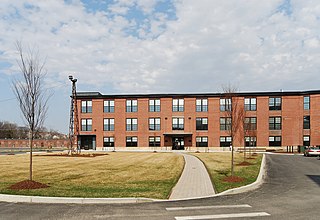
The United States Rubber Company Mill Complex is a historic industrial facility in Providence, Rhode Island. It is a large complex of factory buildings covering about 23 acres (9.3 ha) on the north bank of the Woonasquatucket River. It is bounded on the west by Ericson Place, the north by Valley Street, and the east by Hemlock Street. The property includes 29 historic buildings, built between c. 1885 and c. 1960, as well as three bridges. The buildings are predominantly brick structures, ranging in height from one to five stories, and were built either by the Joseph Banigan Rubber Company, its successor the United States Rubber Company, or the American Locomotive Company, whose property east of the rubber works was acquired by the US Rubber Company in 1918. Only four buildings built by these companies are known to have been demolished before 1960. The plant closed in 1975, and has since been adapted to a variety of other uses.

The Crompton Mill Historic District is a historic district encompassing a mill complex at 20 Remington Street, 53 and 65 Manchester Street in West Warwick, Rhode Island. The mill complex consists of a collection of mainly brick buildings, bounded by the Pawtuxet River and Pulaski, Remington, and Manchester Streets in the village of Crompton. The mill complex formerly extended across the river, but the complex on the west bank was destroyed by fire in 1992. The oldest elements of the complex are the dam site and some of the raceways that provided water power to the mills. The present dam was built in 1908, replacing an 1882 structure. The raceways were built in 1807, around the time of the first mill buildings. The stone Mill No. 1, built 1807, is believed to be the oldest stone mill building in the state. Most of the complex's buildings were built in the late 19th and early 20th centuries by the Providence Manufacturing Company and its successors. The mill was used for textile processing until 1946, when the Crompton Corporation ended production.

The Conant Thread—Coats & Clark Mill Complex District is a historic district encompassing a large industrial complex which straddles the border between Pawtucket and Central Falls, Rhode Island. This 50-acre (20 ha) industrial area was developed in two phases, with a number of buildings surviving from both of these periods. The first, between 1870 and 1882, resulted in the construction of Mills 2 through 5, a series of large three- and four-story brick buildings which were used in textile manufacturing. A brick office and stables from this period were demolished in 1977, and are the only known brick structures to have been lost. The second phase of construction was between 1917 and 1923, and included the construction of two additional four-story brick mills, a stuccoed recreation hall that has since been converted into a senior center, two two-story brick buildings, and a power plant. This works was first developed by J & P Coats, and became an internationally known source for cotton thread. It was for many years Pawtucket's largest employer.
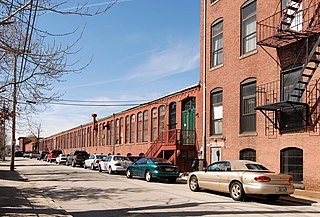
The Hope Webbing Company Mill is a historic textile mill at 999-1005 Main Street in Pawtucket, Rhode Island. The three brick buildings on this 7-acre (2.8 ha) are the surviving elements of what was once a larger complex, extending across Esten Avenue. The oldest portion of the main mill and the boiler house were built in 1889, with the mill growing by numerous additions through 1914. The preparing building was built in 1902 and enlarged in 1913. The Hope Webbing Company was established in 1883, and used these premises to manufacture narrow fabrics using many different types of fibers, including cotton, jute, wool, and silk. The company occupied all or part of the premises until 1994, when it moved its remaining production to Cumberland.

The Valley Falls Company was founded in 1839 by Oliver Chace, in Valley Falls, Rhode Island, a historic mill village on both sides of the Blackstone River, within the modern-day town of Cumberland and city of Central Falls, Rhode Island. The Valley Falls Company is the original antecedent of Berkshire Hathaway, currently one of the world's largest and most successful companies.

Mill Conversion or mill rehab is a form of adaptive reuse in which a historic mill or industrial factory building is restored or rehabilitated into another use, such as residential housing, retail shops, office, or a mix of these non-industrial elements (mixed-use).

The Jules Desurmont Worsted Company Mill is a historic mill at 84 Fairmount Street in Woonsocket, Rhode Island. The mill complex consists of three brick buildings, erected 1907-10 by Jules Desurmont, the owner of a textile firm in Tourcoing, a city in northern France, who had been drawn to Woonsocket by the promotional activities of Aram Pothier. The mill produced French worsted wool yarn until 1952, and was used for many years thereafter by smaller textile and industrial concerns.
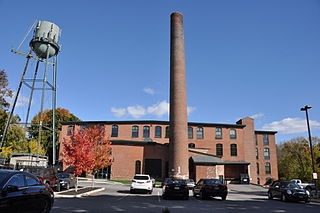
The Pocasset Worsted Company Mill is an historic industrial complex at 75 Pocasset Street in Johnston, Rhode Island. It consists of a complex of four connected brick buildings, built between 1897 and 1902. The buildings form a rough U shape on a 3.38 acres (1.37 ha) parcel of land between Pocasset Street and the Pocasset River. The two legs of the U are nearly identical main mill buildings, constructed in 1897 and 1902; they are joined by an engine and boiler house. The mill office building is attached to the southern (1897) mill building. The Pocasset Worsted Company was Johnston's largest employer in the early 20th century; its buildings were used for textile production until 1989.
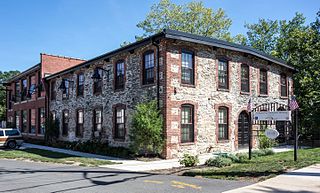
The Heaton and Cowing Mill is a historic industrial facility at 1115 Douglas Avenue in Providence, Rhode Island. The small mill complex consists of three connected building sections; the oldest is a c. 1832 rubble-walled two story mill building constructed by David Heaton and Martin Cowing on the banks of the West River. The partners used the facility to manufacture and dye cotton cloth. The building is the remnant of a much larger Geneva Worsted Company works that Heaton and Cowing built on the site in the 1860s and 1870s. The building was used, with a major brick addition c. 1930, for textile production until the 1950s, until its last textile owner, the Wanskuck Mill, shut down. It served a variety of light industrial businesses, and in 1982 a concrete block building was added to its rear. Most of its original waterworks infrastructure has either been filled in, or was destroyed by flooding in 2010.

Blackstone River Valley National Historical Park is a National Park Service unit in the states of Rhode Island and Massachusetts. The park was created for the purpose of preserving, protecting, and interpreting the industrial heritage of the Blackstone River Valley and the urban, rural, and agricultural landscape of that region. The Blackstone River Valley was the site of some of the earliest successful textile mills in the United States, and these mills contributed significantly to the earliest American Industrial Revolution. The subsequent construction of the Blackstone Canal, a few years after the successful completion of the Erie Canal, helped to sustain the region's industrial strength.

The American Supply Company Building is a historic industrial building at 1364 Broad Street in Central Falls, Rhode Island. Built in 1876, it was home to a prominent regional manufacturer of loom parts supplied to the area's textile manufacturers. The building was listed on the National Register of Historic Places in 2017. As of 2017, it is vacant and owned by the city, which is considering adaptive reuse for the property.

The Cargill Falls Mill, also known historically as the Wilkinson Mill, is a historic textile mill complex at 52-58 Pomfret Street in Putnam, Connecticut. Founded in 1806, it is one of the state's oldest mill complexes, and it retains examples of mill architecture spanning more than 175 years. It was listed on the National Register of Historic Places in 2014.

The Jenckes Spinning Company is a historic textile factory complex in Pawtucket, Rhode Island. Located on Conant and Weeden Streets, the complex was developed between 1883 and 1919, and was home to the city's largest employer in the 1910s, producing cotton fabric and fabric for use in automotive tires until 1933. The factory complex was listed on the National Register of Historic Places in 2018.

The Andrews Mill Company Plant is a historic industrial complex at 761 Great Road in North Smithfield, Rhode Island. Built beginning in 1918, it was home to a maker of French worsted wool textiles, part of a major industrial development push in northern Rhode Island at the time. The complex was listed on the National Register of Historic Places in 2018.









